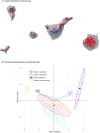Evolution and conservation genetics of an insular hemiparasitic plant lineage at the limit of survival: the case of Thesium sect. Kunkeliella in the Canary Islands
- PMID: 35289923
- PMCID: PMC9415105
- DOI: 10.1002/ajb2.1830
Evolution and conservation genetics of an insular hemiparasitic plant lineage at the limit of survival: the case of Thesium sect. Kunkeliella in the Canary Islands
Abstract
Premise: The diversification of island flora has been widely studied. However, the role of environmental niches in insular radiation processes has been less investigated. We combined population genetic analyses with species distribution modelling to clarify the genetic relationships, diversification patterns, species niche requirements, and conservation of Thesium sect. Kunkeliella, a clade of rare hemiparasitic plants endemic to the Canaries.
Methods: We studied the three extant Thesium species and a new taxon from La Palma Island. We developed 12 microsatellites and performed population genetic analysis and studied the demographic history of the group. To evaluate the role of niche conservatism in the diversification of the group, we performed species distribution modelling (ESM) with four algorithms.
Results: All species presented moderate genetic diversity values for rare endemics. Thesium canariense (Gran Canaria) showed high differentiation, whereas T. subsucculentum, T. retamoides (Tenerife), and La Palma populations are closely related. The lineage may have undergone a recent diversification with colonization proceeding east to west, with T. canariense as sister to the others. We detected a climatic niche shift, as taxa showed different distributions across the temperature gradient. There is enough evidence to describe La Palma populations as a new species.
Conclusions: We characterized the evolutionary history of Thesium sect. Kunkeliella by integrating genetic and ecological assessments. Our results indicate that this clade has undergone a recent radiation process with niche differentiation among species. The results increase our knowledge about insular radiations and will inform the conservation management of the study species.
Keywords: Santalaceae; endangered species; endemic; insular radiation; microsatellites; niche conservatism; species distribution modeling.
© 2022 Botanical Society of America.
Figures





Similar articles
-
Reconstruction of the spatio-temporal diversification and ecological niche evolution of Helianthemum (Cistaceae) in the Canary Islands using genotyping-by-sequencing data.Ann Bot. 2021 Apr 17;127(5):597-611. doi: 10.1093/aob/mcaa090. Ann Bot. 2021. PMID: 32386290 Free PMC article.
-
Complex population genetic structure in the endemic Canary Island pine revealed using chloroplast microsatellite markers.Theor Appl Genet. 2003 Oct;107(6):1123-31. doi: 10.1007/s00122-003-1320-2. Epub 2003 Oct 2. Theor Appl Genet. 2003. PMID: 14523525
-
Contrasting evolutionary processes during Quaternary climatic changes and historical orogenies: a case study of the Japanese endemic primroses Primula sect. Reinii.Ann Bot. 2017 Nov 28;120(6):943-954. doi: 10.1093/aob/mcx108. Ann Bot. 2017. PMID: 29040379 Free PMC article.
-
A review of the ethnobotany, contemporary uses, chemistry and pharmacology of the genus Thesium (Santalaceae).J Ethnopharmacol. 2020 Jun 28;256:112745. doi: 10.1016/j.jep.2020.112745. Epub 2020 Mar 15. J Ethnopharmacol. 2020. PMID: 32188571 Review.
-
Morphology, Behaviour and Evolution of Gallotia Lizards from the Canary Islands.Animals (Basel). 2023 Jul 15;13(14):2319. doi: 10.3390/ani13142319. Animals (Basel). 2023. PMID: 37508096 Free PMC article. Review.
Cited by
-
Genotyping-by-sequencing informs conservation of Andean palms sources of non-timber forest products.Evol Appl. 2024 Jul 31;17(8):e13765. doi: 10.1111/eva.13765. eCollection 2024 Aug. Evol Appl. 2024. PMID: 39091352 Free PMC article.
References
-
- Aguilar, R. , Quesada M., Ashworth L., Herrerias‐Diego Y., and Lobo J.. 2008. Genetic consequences of habitat fragmentation in plant populations: susceptible signals in plant traits and methodological approaches. Molecular Ecology 17: 5177–5188. - PubMed
-
- Albaladejo, R. G. , Martín‐Hernanz S., Reyes‐Betancourt J. A., Santos‐Guerra A., Olangua‐Corral M., Aparicio A., Reyes‐Betancort J. A., et al. 2020. Reconstruction of the spatio‐temporal diversification and ecological niche evolution of Helianthemum (Cistaceae) in the Canary Islands using genotyping‐by‐sequencing data. Annals of Botany 9: mcaa0 90. - PMC - PubMed
-
- Ascaso, J. , and Pedrol J.. 2002. Santalaceae. In López Sáez J. L., Catalán P., and Sáez Ll. [eds.], Plantas parásitas de la Península Ibérica y Baleares, 300–320. Ediciones Mundi Prensa, Madrid, Spain.
-
- Bañares‐Baudet, Á. , Blanca G., Güemes J., Moreno‐Saiz J. C., and Ortiz S.. 2004. Atlas y libro rojo de la flora vascular amenazada de España. Dirección General de Conservación de la Naturaleza, Madrid, Spain.
-
- Barrera Acosta, J. , González González R., and Beltrán Tejera E.. 2011. Kunkeliella subsucculenta. The IUCN red list of threatened species: e.T161943A5517012. International Union for Conservation of Nature, Gland, Switzerland. Website: https://www.iucnredlist.org/species/161943/5517012 [accessed 8 February 2022].
Publication types
MeSH terms
LinkOut - more resources
Full Text Sources

